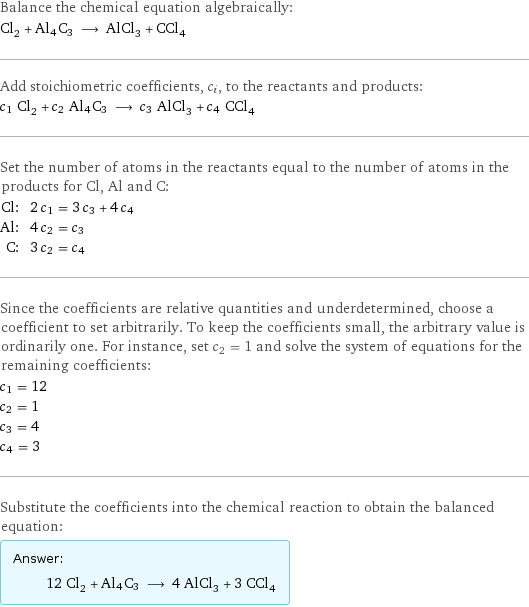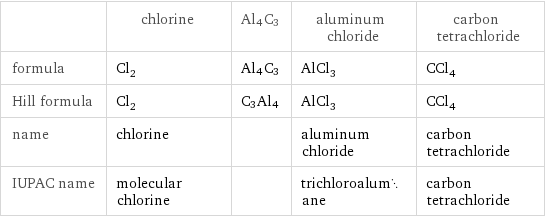Input interpretation

Cl_2 chlorine + Al4C3 ⟶ AlCl_3 aluminum chloride + CCl_4 carbon tetrachloride
Balanced equation

Balance the chemical equation algebraically: Cl_2 + Al4C3 ⟶ AlCl_3 + CCl_4 Add stoichiometric coefficients, c_i, to the reactants and products: c_1 Cl_2 + c_2 Al4C3 ⟶ c_3 AlCl_3 + c_4 CCl_4 Set the number of atoms in the reactants equal to the number of atoms in the products for Cl, Al and C: Cl: | 2 c_1 = 3 c_3 + 4 c_4 Al: | 4 c_2 = c_3 C: | 3 c_2 = c_4 Since the coefficients are relative quantities and underdetermined, choose a coefficient to set arbitrarily. To keep the coefficients small, the arbitrary value is ordinarily one. For instance, set c_2 = 1 and solve the system of equations for the remaining coefficients: c_1 = 12 c_2 = 1 c_3 = 4 c_4 = 3 Substitute the coefficients into the chemical reaction to obtain the balanced equation: Answer: | | 12 Cl_2 + Al4C3 ⟶ 4 AlCl_3 + 3 CCl_4
Structures

+ Al4C3 ⟶ +
Names

chlorine + Al4C3 ⟶ aluminum chloride + carbon tetrachloride
Equilibrium constant
![Construct the equilibrium constant, K, expression for: Cl_2 + Al4C3 ⟶ AlCl_3 + CCl_4 Plan: • Balance the chemical equation. • Determine the stoichiometric numbers. • Assemble the activity expression for each chemical species. • Use the activity expressions to build the equilibrium constant expression. Write the balanced chemical equation: 12 Cl_2 + Al4C3 ⟶ 4 AlCl_3 + 3 CCl_4 Assign stoichiometric numbers, ν_i, using the stoichiometric coefficients, c_i, from the balanced chemical equation in the following manner: ν_i = -c_i for reactants and ν_i = c_i for products: chemical species | c_i | ν_i Cl_2 | 12 | -12 Al4C3 | 1 | -1 AlCl_3 | 4 | 4 CCl_4 | 3 | 3 Assemble the activity expressions accounting for the state of matter and ν_i: chemical species | c_i | ν_i | activity expression Cl_2 | 12 | -12 | ([Cl2])^(-12) Al4C3 | 1 | -1 | ([Al4C3])^(-1) AlCl_3 | 4 | 4 | ([AlCl3])^4 CCl_4 | 3 | 3 | ([CCl4])^3 The equilibrium constant symbol in the concentration basis is: K_c Mulitply the activity expressions to arrive at the K_c expression: Answer: | | K_c = ([Cl2])^(-12) ([Al4C3])^(-1) ([AlCl3])^4 ([CCl4])^3 = (([AlCl3])^4 ([CCl4])^3)/(([Cl2])^12 [Al4C3])](../image_source/9450a2ea0e591e43a3fd0eb03683d050.png)
Construct the equilibrium constant, K, expression for: Cl_2 + Al4C3 ⟶ AlCl_3 + CCl_4 Plan: • Balance the chemical equation. • Determine the stoichiometric numbers. • Assemble the activity expression for each chemical species. • Use the activity expressions to build the equilibrium constant expression. Write the balanced chemical equation: 12 Cl_2 + Al4C3 ⟶ 4 AlCl_3 + 3 CCl_4 Assign stoichiometric numbers, ν_i, using the stoichiometric coefficients, c_i, from the balanced chemical equation in the following manner: ν_i = -c_i for reactants and ν_i = c_i for products: chemical species | c_i | ν_i Cl_2 | 12 | -12 Al4C3 | 1 | -1 AlCl_3 | 4 | 4 CCl_4 | 3 | 3 Assemble the activity expressions accounting for the state of matter and ν_i: chemical species | c_i | ν_i | activity expression Cl_2 | 12 | -12 | ([Cl2])^(-12) Al4C3 | 1 | -1 | ([Al4C3])^(-1) AlCl_3 | 4 | 4 | ([AlCl3])^4 CCl_4 | 3 | 3 | ([CCl4])^3 The equilibrium constant symbol in the concentration basis is: K_c Mulitply the activity expressions to arrive at the K_c expression: Answer: | | K_c = ([Cl2])^(-12) ([Al4C3])^(-1) ([AlCl3])^4 ([CCl4])^3 = (([AlCl3])^4 ([CCl4])^3)/(([Cl2])^12 [Al4C3])
Rate of reaction
![Construct the rate of reaction expression for: Cl_2 + Al4C3 ⟶ AlCl_3 + CCl_4 Plan: • Balance the chemical equation. • Determine the stoichiometric numbers. • Assemble the rate term for each chemical species. • Write the rate of reaction expression. Write the balanced chemical equation: 12 Cl_2 + Al4C3 ⟶ 4 AlCl_3 + 3 CCl_4 Assign stoichiometric numbers, ν_i, using the stoichiometric coefficients, c_i, from the balanced chemical equation in the following manner: ν_i = -c_i for reactants and ν_i = c_i for products: chemical species | c_i | ν_i Cl_2 | 12 | -12 Al4C3 | 1 | -1 AlCl_3 | 4 | 4 CCl_4 | 3 | 3 The rate term for each chemical species, B_i, is 1/ν_i(Δ[B_i])/(Δt) where [B_i] is the amount concentration and t is time: chemical species | c_i | ν_i | rate term Cl_2 | 12 | -12 | -1/12 (Δ[Cl2])/(Δt) Al4C3 | 1 | -1 | -(Δ[Al4C3])/(Δt) AlCl_3 | 4 | 4 | 1/4 (Δ[AlCl3])/(Δt) CCl_4 | 3 | 3 | 1/3 (Δ[CCl4])/(Δt) (for infinitesimal rate of change, replace Δ with d) Set the rate terms equal to each other to arrive at the rate expression: Answer: | | rate = -1/12 (Δ[Cl2])/(Δt) = -(Δ[Al4C3])/(Δt) = 1/4 (Δ[AlCl3])/(Δt) = 1/3 (Δ[CCl4])/(Δt) (assuming constant volume and no accumulation of intermediates or side products)](../image_source/43fab7d944cb0a32f304d5a1cc699ccd.png)
Construct the rate of reaction expression for: Cl_2 + Al4C3 ⟶ AlCl_3 + CCl_4 Plan: • Balance the chemical equation. • Determine the stoichiometric numbers. • Assemble the rate term for each chemical species. • Write the rate of reaction expression. Write the balanced chemical equation: 12 Cl_2 + Al4C3 ⟶ 4 AlCl_3 + 3 CCl_4 Assign stoichiometric numbers, ν_i, using the stoichiometric coefficients, c_i, from the balanced chemical equation in the following manner: ν_i = -c_i for reactants and ν_i = c_i for products: chemical species | c_i | ν_i Cl_2 | 12 | -12 Al4C3 | 1 | -1 AlCl_3 | 4 | 4 CCl_4 | 3 | 3 The rate term for each chemical species, B_i, is 1/ν_i(Δ[B_i])/(Δt) where [B_i] is the amount concentration and t is time: chemical species | c_i | ν_i | rate term Cl_2 | 12 | -12 | -1/12 (Δ[Cl2])/(Δt) Al4C3 | 1 | -1 | -(Δ[Al4C3])/(Δt) AlCl_3 | 4 | 4 | 1/4 (Δ[AlCl3])/(Δt) CCl_4 | 3 | 3 | 1/3 (Δ[CCl4])/(Δt) (for infinitesimal rate of change, replace Δ with d) Set the rate terms equal to each other to arrive at the rate expression: Answer: | | rate = -1/12 (Δ[Cl2])/(Δt) = -(Δ[Al4C3])/(Δt) = 1/4 (Δ[AlCl3])/(Δt) = 1/3 (Δ[CCl4])/(Δt) (assuming constant volume and no accumulation of intermediates or side products)
Chemical names and formulas

| chlorine | Al4C3 | aluminum chloride | carbon tetrachloride formula | Cl_2 | Al4C3 | AlCl_3 | CCl_4 Hill formula | Cl_2 | C3Al4 | AlCl_3 | CCl_4 name | chlorine | | aluminum chloride | carbon tetrachloride IUPAC name | molecular chlorine | | trichloroalumane | carbon tetrachloride
Substance properties

| chlorine | Al4C3 | aluminum chloride | carbon tetrachloride molar mass | 70.9 g/mol | 143.959 g/mol | 133.3 g/mol | 153.8 g/mol phase | gas (at STP) | | solid (at STP) | liquid (at STP) melting point | -101 °C | | 190 °C | -23 °C boiling point | -34 °C | | | 76.5 °C density | 0.003214 g/cm^3 (at 0 °C) | | | 1.594 g/cm^3 solubility in water | | | | insoluble surface tension | | | | 0.0269 N/m dynamic viscosity | | | | 9.08×10^-4 Pa s (at 25 °C) odor | | | | ether-like
Units
